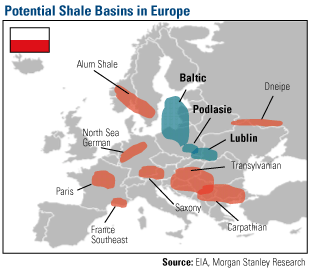
The European Union now imports 30 percent of its natural gas from Russia, says Morgan Stanley, and Poland has been one of the best customers. Last year, Poland alone imported nearly 63 percent of its natural gas—87 percent originating in Russia. The chart shows the vast web of pipelines that Russia has spun through Belarus, Ukraine, Slovakia and the Czech Republic in order to carry its gas to the other European nations.
BP reports that the only country outproducing Russia in natural gas is the U.S., which accounted for nearly one-fifth of the world’s natural gas in 2010. However, the U.S.’s natural gas production rose to its highest level since 1973 due to the extraction of shale gas. “Shale gas related horizontal drilling surged in early 2010 and shale gas output rose to account for 23 percent of total U.S. production,” reported BP.The U.S’s new drilling technique, which extracts natural gas from rock deep underground, is “reshaping the world of natural gas,” BP says. To unlock the resource in shale basins, engineers must employ horizontal and hydraulic drilling, commonly referred to as “fracking” or “hydrofracking.” This requires pumping highly pressurized amounts of water, chemicals and sand underground to release gas trapped in shale formations.
Now this groundbreaking technique could shift Europe’s natural gas market to the East. A report by the U.S. Energy Information Administration (EIA) on “World Shale Gas Resources” found that Poland has the largest shale gas reserves in all of Europe, with 187 trillion cubic feet of recoverable natural gas resources.
Specifically, the EIA finds three organically rich shale formations in Poland that are favorable for gas exploration development.
The Baltic Basin is roughly 102,000 total square miles in size, larger than the Marcellus shale basin in the U.S., and extends over a portion of Poland, Lithuania, Russia, Latvia, Sweden and the Baltic Sea. This basin could contain significant levels of natural gas, making it the most promising deposit of this untapped resource in the region. Surrounding the Baltic Basin are Poland’s gas-rich regions of the Lublin and Podlasie basins.Chevron began drilling the company’s first exploratory well in southeast Poland this week and that’s just the beginning. The EIA says a number of international firms such as ExxonMobil, Marathon Oil and PGNiG, Poland’s state-owned gas company, have been evaluating the Baltic and Lublin basins, but no exploratory wells have been drilled at Podlasie as of yet. Substantial infrastructure is also needed for companies to be able to extract and transport reserves, including thousands of miles of pipelines and dozens of rigs.
Helping to offset some of the transportation difficulties, Poland’s largest state-owned energy company recently announced plans to build approximately 620 miles of gas pipeline.Although it may still be two to five years until the country is able to begin production, Morgan Stanley cites several reasons for Poland’s likely success: a large resource base, gas pricing that is almost twice the pricing of the U.S., a developed gas market, and political support that welcomes foreign firms and hydraulic fracking permits compared to other countries in Europe. Just as shale gas is significantly driving the supplies of natural gas in the U.S., Poland’s shale gas could shift where Europe gets its energy in the future.
